The Samsung Galaxy Note5 and Galaxy S6 edge+ Review
by Joshua Ho on October 2, 2015 8:00 AM ESTDisplay
With the rise of smartphones and tablets, the display has become one of the most important aspects of a mobile device as it’s the primary mode of interaction. However, throughout computing the display has generally had relatively little attention. People might have talked about resolution, size, and latency, but the discourse was vague at best. In order to really understand displays, it’s important to discuss a number of factors that affect display quality and the underlying design of the display. These factors range from subpixel arrangement to TFT structure and various emitter materials. With traditional reviewing methods, it’s often difficult to say one way or another whether one display is “better” than another. While simple metrics like maximum brightness can be compared in a relative manner, it’s hard to say whether one has better colors or higher static contrast. In order to test these metrics, we turn to objective measurements from devices like X-Rite’s i1Pro2 spectrophotometer and i1Display Pro colorimeter. In order to acquire the data from these devices and present it in a usable manner, we use SpectraCal’s CalMAN 5 with a custom workflow.
Under the microscope and based upon some quick viewing angle tests, subjectively the Galaxy Note5 display looks and feels like a bigger version of the Galaxy S6 display. Viewing angles for some angles feels like the display is almost painted on to the glass below, but some odd interference effects with viewing angle changes breaks the illusion to some extent. In the case of the S6 edge+, the curved edges of the display cause a noticeable shift in luminance when looking at the edge compared to the center of the display, which also causes an odd green shift which is probably due to the RGBG subpixel layout. I suspect the best LCDs will still be better at the “painted to the glass” illusion for the near future. This isn’t a huge deal, but it is a noticeable difference.
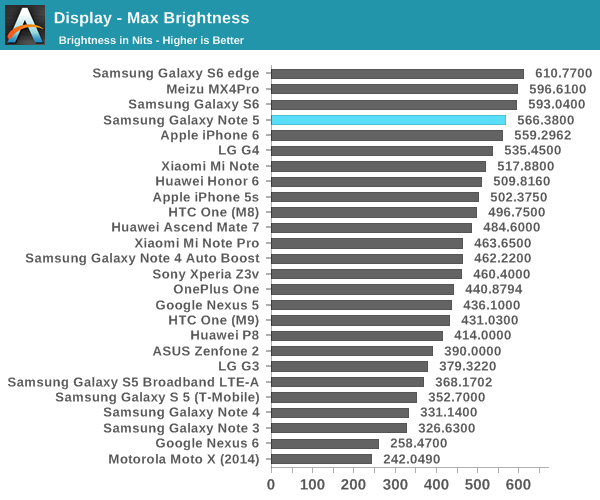
Moving on to our brightness testing, we can see that the Galaxy Note5 delivers a healthy improvement over the Galaxy Note 4 generation of AMOLED, but it isn’t quite at the same level as the Galaxy S6. It isn’t clear why this is the case, but I suspect this is related to longevity and other concerns outside of brightness. Meanwhile the use of OLED means that black levels are perfect and contrast remains solely determined by the lighting of the room and the reflectance of the display, which is similar to most other smartphones.
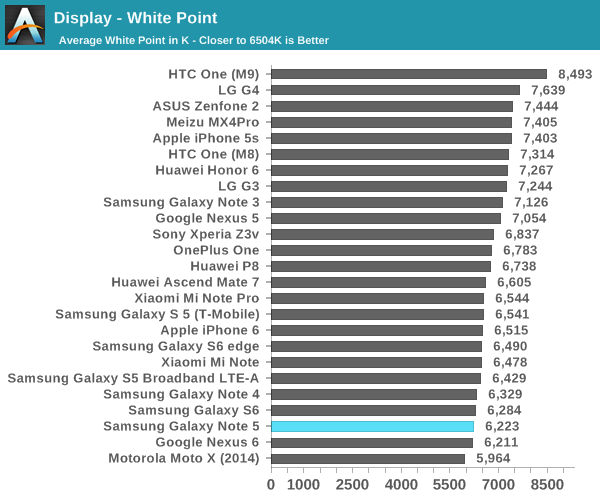
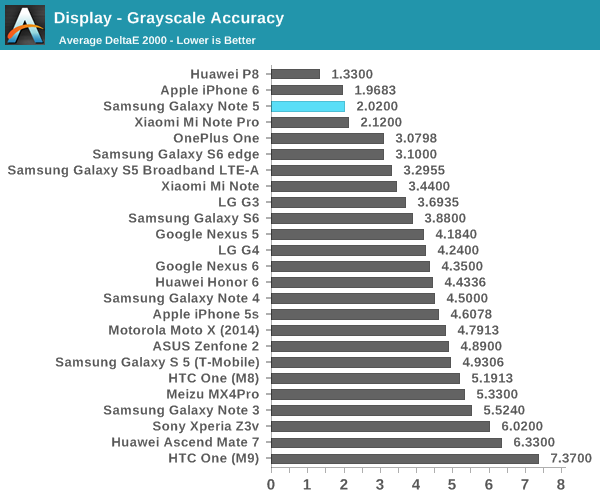
In our standard grayscale testing, the Note5 delivers acceptable color accuracy but it seems that the Basic screen mode tends towards a warm color balance. I suspect this helps with power efficiency, as blue in general requires more power to achieve the same level of luminance. Other than this slightly warm white balance, the grayscale accuracy doesn’t have any significant errors. This means accuracy ends up very good - certainly below our threshold for noticable errors - especially in comparison to the Galaxy Note 4 which had some noticeable problems with green tint on some units.
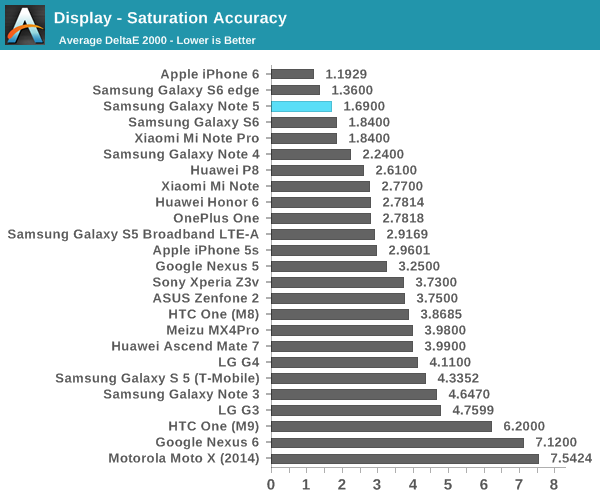
In our saturation test, Samsung does well enough that there’s really nothing to talk about because there's so little wrong here. You could argue that magenta is a bit warm on our review unit, but the difference is too small to be worth talking about. Error on average is going to be hard to spot unless you have a flawless reference monitor to compare against.
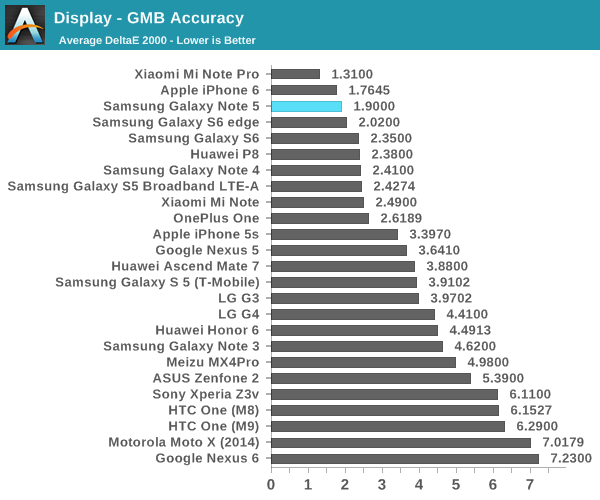
In the GMB ColorChecker test, Samsung continues to show a strong performance when looking at various hues that are commonly found in consumer content such as movies and camera photos. There’s a slight red shift on some of the tested hues, but the error is so minor I don’t notice that any problems here.
Overall, the Galaxy Note5 and Galaxy S6 edge+ both have an incredible display. The Galaxy S6 edge+ does have some problems with viewing angle shifts by virtue of the curved display, but this is effectively unavoidable given the subpixel layout and the radius of curvature. With this generation of AMOLED, Samsung has definitely equaled the best LCDs on the market. I suspect within the next year or two it will be inevitable that Samsung AMOLED will be clearly superior to even the best LCDs. However, without other OLED suppliers that can provide similar quality and cost I suspect OEM adoption will continue to be limited.



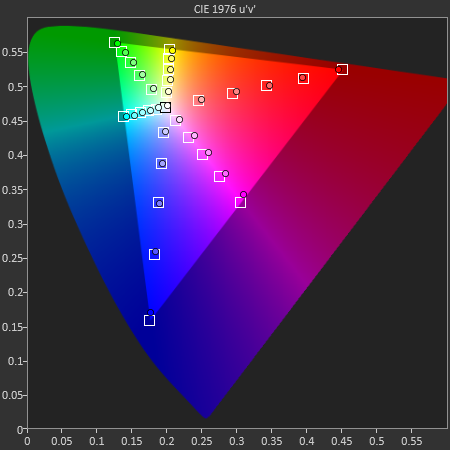
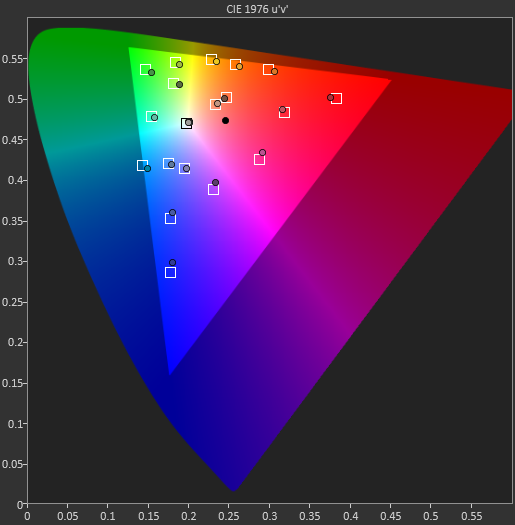








225 Comments
View All Comments
lilmoe - Sunday, October 4, 2015 - link
Samsung is selling Exynos to anyone willing to buy...Tech_guy - Friday, October 2, 2015 - link
Why weren't 6s benchmarks included? This is stupid, and misleading. You're trying to make Samsung look good. It'll embarrass the Note 5, like iPhone 6s is about 4 times the onscreen graphics performance lol. Did Samsung increase their advertising on Ananadtech.com?freeskier93 - Saturday, October 3, 2015 - link
Dude chill out, these phones were released before the 6s/+. The full 6s/+ review isn't even out yet so it only makes sense.thedons1983 - Sunday, October 18, 2015 - link
What a pathetic faggot. Please don't breed, as the world has enough ill-informed morons as it is!!secretmanofagent - Friday, October 2, 2015 - link
No mention at all of it dropping multitasking? This is an important question.randomlm - Friday, October 2, 2015 - link
A few errors in this review,1 . At the front page, Note 4 rear camera's aperture is stated as F/2.0, it is actually F2.2
2. At the battery life page it is stated that note 4 has a "planar 20nm process". This is only true for Exynos Note 4 which has the 5433, but it appears on the front page that the Snapdragon Note 4 is being compared instead, which has a 28 nm process.
3. On the camera architecture page, the front camera's aperture of Note 4 is stated as F2.4. It should be F1.9.
4. I disagree with the line "Samsung has actually managed to implement low light image processing that's good enough to beat" ( Lightroom's noise reduction ability). Not a fair comparison. In JPEG shots, samsung has been known to always activate "night mode", which uses a sort of "image stacking" process by combining (my guess is 3) images taken in quick succession to reduce noise (and improving the SNR of an image). By using raw, only one image of shutter speed 1/7 is taken. With only 1 image worth of data to process, the lightroom processed image will definitely lose out! But your point is there, that samsung's really good at JPG processing for night photos.
Still a pretty good review, thanks.
Ryan Smith - Friday, October 2, 2015 - link
Thanks randomlm. I've taken care of 2 and 3. As for item #1, in my notes I have it down as 2.0, but I will get Josh to check this.beck2448 - Friday, October 2, 2015 - link
Note 5 is awesome. Moved up from the 3. Screen is clearly the best in business including the iphone.Fast and great camera. Low light pix much better. It's a winner.
nerd1 - Friday, October 2, 2015 - link
Okay now I absolutely hate anandtech reviews. THEY INTENTIONALLY OMITTED ANY COMPARISON THAT MAKE APPLE DEVICES LOOK BAD.-Display review lacks contrast and outdoor contrast (both AMOLED dominates)
-Browser benchmark uses terrible mobile chrome, not stock browser which is way better.
-Processor benchmark lacks any multithread benchmarks (like geekbench multi)
-NAND R/W results makes absolutely sense at all, compared to this http://blog.gsmarena.com/samsung-galaxy-s6-storage...
-Camera comparison only shows the focus lag comparison and no resolution / noise / dynamic range that actually matters
I'm really surprised to see this low level of journalism at anandtech. Why cherry pick test results to make apple device look the best? Even worse thing is that most people will take those graphs as 'unbiased and technical'
Yanic - Saturday, October 3, 2015 - link
If this is the case, then this will be the last Anandtech review I ever read. Really sad.